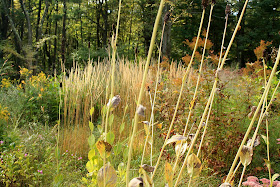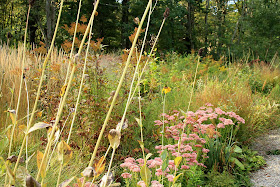Fall arrived this past weekend. The sun was shining full at a low angle, bringing the first intimations of the season's glowing golds, yellows, oranges and reds, stippled by purple asters, black seed heads, fruits and berries that announce the end of the garden year. The fermenting fragrances of autumn soon will begin to rise from the earth.
This set of sun-lit photos contrasts with the twilight photos in the previous post. Click on this
link to see that post.
 |
| Leaf-strewn terrace overlooking the garden. The worn blue stone paving dates to the mid-1960s giving the modest sitting area a patina of age. |
 |
| Late blooming Lespedeza thunbergii 'Gibraltar'. |
 |
| Geranium 'Rozanne'. |
 |
| Steps down to the garden, of native argillite stone. |
 |
| The small pond surrounded by mounds of debris just heaved out. |
 |
| The bank up to the house, still a work in progress. |
 |
| As the sun drops behind the trees, theatrical shafts of light create moments of transient radiance. |
 |
| Panicum virgatum 'Shenandoah'. |
 |
| Filipendula rubra 'Venusta' in its copper phase, asters yet to bloom behind. |
 |
| The native Seedbox (Ludwigia alternifolia). |
 |
| Rods of Rudbeckia maxima, Goldenrod, some of which I must pull out to control its spread. |
 |
| Looking across the garden toward the east. |
 |
| Tall Silphiums and Rudbeckias dominate here earlier in the season. More interesting ground level plantings are in the works ... orange daylilies in grass, Pycnanthemum muticum, Rudbeckia 'Henry Eilers'. |
 |
| Serpentine wall. |
 |
| Wave Hill chair with Miscanthus purpurescens on right. |
 |
| Looking up toward the house. Is refuge in the house or is it in the garden? |
 |
| Back path with partially planted area on the left. I just seeded Sorgastrum nutans, which is endemic to this site. |
 |
| Miscanthus 'Silberfeder' and Inula racemosa 'Sonnenspeer'. |
 |
| View across bracken toward six red walnut logs, with new Miscanthus giganteus making a partial wall behind. |
 |
| Hidden path into interior sitting area. |
 |
| Pycnanthemum muticum and Panicum. |
 |
| A place to sit, like a nest among tall perennials. |
 |
| Late blooming vernonia with asters and blue lobelia. |
 |
| Pycnanthemum tenuifolium, naturally occurring on this site. |
 |
| Vernonia seed heads. |
 |
| Inula and Miscanthus purpurescens. |
 |
| Looking toward the hidden terrace. |
 |
| Mystical 'omphalos' of the garden. |
 |
| The elevated box hedge slowly merging with the garden as perennials seed into the planting. I do have to control this. |
 |
| Great blue lobelia randomly seeded in. |
 |
| White Eupatorium perfoliatum and Great blue lobelia, with a large self-seeded Patrinia scabiosifolia between, randomly timed to grow tall and bloom next year. Hydrangea quercifolia behind. |
 |
| Looking across to the woods. Patterns of light shift moment to moment. |
















































That angled autumn light suits your garden like no other...splendid!
ReplyDeleteThanks. It gets better and better, until snow or deluge ends it all. If we're lucky, much of it makes it through winter.
DeleteYour garden is so complex and so wild but controlled. It does amazing things with light. I am still partial to the box planting with the bergenia and the path around it, but all of the combinations of form and light-catching texture and contrast with the minimal hardscape is wonderful. All of it!!
ReplyDeleteI have to fess up to shaggy edges though they don't really bother me. The box planting is morphing in an amazing way. I dropped in some sedum I found in a wet drainage area, and the sedum is gradually climbing the rock base, making the whole planting look as if it's sinking into a sea of green. Strange but pleasant effect. The light-catching plantings are accidental, but once I saw this was a phenomenon I could play up, I started selecting plants that I knew would do this in the fall. Part accident, part intention. I need more sanguisorbas!
DeleteRestrained exuberance? Mannerly chaos? To garden in this way, to have your plantings blend with the surroundings and 'read' as nature (and I don't know the native flora of your area at all, and so could not tell if this is a "natural" garden or not) takes a real eye and a great deal of self assurance. I admire anyone who can take perennials, grasses, and woody plants in nursery pots and plant them in a setting such as yours and have the vision that it will come together. It is difficult to know how and when to edit or enhance a wooded area, meadows and forest margins all the more so. Very well done (the gold tones to the early autumn light does nothing but help, too.)
ReplyDeleteCalvin, I can most definitely tell you it's not a natural garden at all--naturalistic, yes, natural, absolutely no. It's what I like to call, even if not completely accurate, a simulacrum of a wet prairie. I do use some plants from the tall grass prairies that used to exist in the center of our continent, but I also use a lot of Miscanthus (from Japan) and other "exotics." It's perhaps possible to call it "natural" in the sense that the plants that are chosen and that remain over time are well suited to the local conditions and seem to thrive in the woodland edge environment and in wet clay. I might call it a "light catcher" to steal a phrase from cyber friend and fellow blogger Peter Holt (opensesamegarden.blogspot.com. Ecologists and native plant people will hate me, but I think I'm preparing for the garden of the future, when we will have to grow plants adapted to our dramatically changed climate.
ReplyDeleteJames this 'finale' needs to play on. Hopefully you will get a full Autumn (no rogue October snow storms) as for my money, this really is THE season for your garden.
ReplyDeleteI wonder how many types of Miscanthus you grow? A post maybe?
cheers
PS, re last post, I'm in the 'get it' camp.
No doubt about it, Rob. Late summer is good and the "decline" through autumn is the peak time for this garden. Also the peak time for my temperament. I wish I knew about many of the Miscanthus. Unfortunately, or fortunately, they self seed with abandon. The finer cultivars seem not to do that, but the cheaper ones I buy from the "big box" stores seem to be seed-grown strains that reproduce easily. I don't trust their labels to be correct. So I have many mongrel Miscanthus. The benefit is that I get more for free. I plan to move a bunch of them next spring to the front of the house, which doesn't have protection from our marauding deer population. Deer hate Miscanthus.
DeleteJames, you ever come across this http://www.rhs.org.uk/getattachment/91824ee0-c494-4146-9b59-6a6dae808205/Miscanthus-Bulletin.aspx
DeleteRob, I enjoyed that. No, I've never seen it before. Does RHS make available such publications free to nonmembers? It's a reminder of what I do have--Miscanthus sinensis: Gracillimus, Silberfeder (several and a favorite), Ferner Osten (not vigorous for me), Zebrinus, Adagio (like a small version of Gracillimus), Yakujima, Morning Light, and Giganteus. Also "generic" Miscanthus, mostly sold as Gracillimus, but something else unknown. The RHS trials list gives me new options, if I can find them available here. Thank you.
DeleteI am jealous of the size of your plot with all the large trees giving you these amazing images. The way the light lits up seedheads and grasses is very special and I think still overlooked by many gardeners and designers
ReplyDeleteAll is relative, it seems. Over the years I've come to think of my garden as on the small side, though the planting area must be about an acre. I'm lucky that the orientation of the house led me to align the garden to take advantage of nice backlighting in the fall. Once the leaves start to fall from the trees, the lighting can become rather dramatic at certain times of day.
Delete